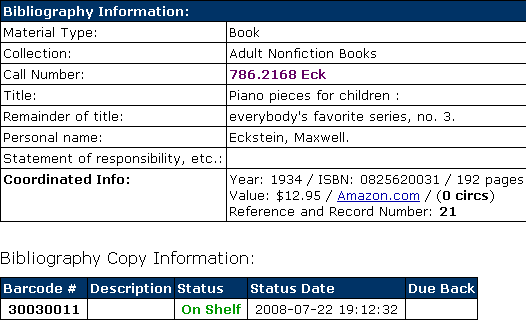How To Install Openbiblio On Windows 7

Installing OpenBiblio Table of Contents 1. System requirements........ Installing OpenBiblio 1.0 on a Windows computer..... Install prerequisite software....... Install OpenBiblio.......
Mar 29, 2016 - Installing OpenBiblio - a step-by-step graphical guide install on. Guide install on Windows using XAMPP - off site; OpenBiblio Installation and. HOW TO INSTALL OPENBIBLIO ON WINDOWS. Operating system: Windows XP. 7) Enter (or copy/past from the string below) in the command line (by.
Using the OpenBiblio installer...... Installing OpenBiblio 1.0 on a shared Linux host..... Installing OpenBiblio 1.0 on a Linux host with full access.... Install prerequisite software....... Install yaz (optional)....... Start the Apache and MySQL services..... Create a MySQL database.......
Prepare OpenBiblio for its installation..... Using the OpenBiblio installer...... System requirements We have tested OpenBiblio installation on Windows 7 and Ubuntu Linux 14.04. We also plan to test other versions of Windows, Ubuntu Linux 12.04, Debian Linux, Fedora Linux, Mac OSX, and CentOS Linux. To install OpenBiblio, you will need PHP version 5.4 or higher. OpenBiblio is fully compatible with PHP 7.
You will need MySQL. OpenBiblio has been tested with versions 5.5 and 5.7.
You will also need some Web server program. OpenBiblio has been tested with both Apache and nginx. Web server software. Installing OpenBiblio 1.0 on a Windows computer You can turn your personal Windows computer into an OpenBiblio server. You will need administrator access to your computer, an Internet connection, and you may also need to check with your local IT experts that you are not behind a restrictive firewall. Note that turning your personal computer into a server carries some risks, especially if your server is broadcasting across the web instead of just a local network. We recommend that you run this software on a dedicated computer that does not contain any sensitive or private data.
Install prerequisite software 1. Download EasyPHP’s Webserver from We have tested these instructions with version 14.1 of EasyPHP.
1 Installing OpenBiblio 2. Agree to the relevant licenses and choose an installation folder that is convenient for you. Once EasyPHP is installed, it will appear as an icon in your system tray. On Windows 7, click on this icon and open the dashboard. The dashboard will open in your default Web browser.
Once it does, click Settings in the top right corner of the screen. Click on HTTP SERVER. Install and start this service. Click on DB SERVER. Install and start this service. Go back to the dashboard. Under modules, you should now see an option to administer MySQL through a program called PhpMyAdmin.
Open PhpMyAdmin. The default username is root and there is no default password.
Click on Users. 10.Click on 'Edit Privileges' next to root. 11.Click on 'Change Password'. 12.Click on Add user. 13.Choose a memorable username, like obiblio, and enter it.
We suggest using a name that only contains letters, numbers, and underscore characters. 14.In the host field, enter 'localhost'. 15.Create a long, secure, memorable password. 16.Under 'Database for user', there should be a checkbox for 'Create database with same name and grant all privileges'. Check this box. Install OpenBiblio 1.
Please proceed with the options below in case none of the above helped: If you have Windows 7 ManyCam driver requires the KB3033929 update, which might be missing from your system. Manycam virtual webcam 3.0.0.80. The procedure is as follows: • ManyCam, • Restart your machine, • compatible with your license or subscription. In case you have a ManyCam 5 license, it is important that you install ManyCam 5.8 from.
Open the EasyPHP dashboard. Go to Settings and open the HTTP SERVER settings. Note the Document Root field. This is the folder on your computer where OpenBiblio will be running. Open the DB SERVER settings.
Note the parameters area. Download OpenBiblio and place the files into the Document Root folder.